Note from Dave: Erica Beaton teaches tenth grade English, US history, and humanities just down the hall from me. In addition to this full-time work, she's also a blogger, a PD provider (who I'm happy to recommend — we've presented together a time or two!) and one of the more resourceful educators I know, creating helpful things like a highly-effective Latin word chunk study pack.
Erica and I share many of the same burning questions as teachers. One of those questions is, simply, How do we maximize the likelihood that the time our students spend with us is impactful not just for the unit test, but for the long-term?
That's what Erica gets into in this thick, juicy article (mmmmm). Prepare to walk away with clearer thinking and actionable strategies.
Take it away, E![hr]

The longer I teach, the more troubled I get by students' forgetfulness.
Yes, I am irked by the fifteen-year-old who doesn't remember to bring a pencil to the final exam, but I am more concerned about the junior who doesn't remember who won the Civil War, which was taught only three years prior in eighth grade, or the sophomore who can't identify the subject and verb of a simple sentence, which seems like it needs to be retaught every year in ELA.
This isn't concerning just because I don't want my students to end up looking like the dummies Jimmy Kimmel finds on the street, but because they have already been taught these major concepts. I am preaching to the choir when I say that teachers work really hard, content demands increase every year, and we don't ever seem to have enough time to do it all.
So if that's the case, I know you feel my frustration about having to waste instructional time each year constantly reteaching students the previous years' standards. Ain't nobody got time for that.
So, with growing demands and reduced time, how do we make our content stick from unit to unit and year to year?
Read Real Research.
 Unlike some of the feel-good-PD books out there that draw solely on anecdotal evidence, Make It Stick: The Science of Successful Learning by Peter C. Brown, Henry L. Roediger III, and Mark A. McDaniel discusses actual scientific research.
Unlike some of the feel-good-PD books out there that draw solely on anecdotal evidence, Make It Stick: The Science of Successful Learning by Peter C. Brown, Henry L. Roediger III, and Mark A. McDaniel discusses actual scientific research.
“Make It Stick turns fashionable ideas…on their head. Drawing on recent discoveries in cognitive psychology and other disciplines, the authors offer concrete techniques for becoming more productive learners.”
I'm not trying to be flippant here but I want to address how annoying it is when educators toss around the “Research proves…” mantra when something isn't actually empirical research.
How many times have you been in a meeting or a Twitter chat when someone says that line but can't supply the study to back up their claim?
Anecdotal evidence has its place, showing impact on one teacher's classroom.
However, this meta-analysis cannot be denied. Even after reading it, I've heard other teachers say, “Oh, well, I don't agree with this… or with that…”
Nope. Sorry. This book isn't a claim for what works. It's the real deal.
If you want your students to retain content knowledge, Make It Stick details what you should and should not do.
On top of that, I just love that the authors, two cognitive scientists and one storyteller, translate this dense meta-analysis into a very approachable, narrative format. It is relatively easy to read because it's meant to help teachers and students “learn better and remember longer.”
Teacher + Student Tips
Below, I've tried to paraphrase the authors' strategies for teachers and for students to increase content retention. Also, I've added some of the specific ways I infuse these strategies into my classes.
Teacher Tip #1: Explain to Students How Learning Works
Unlike ages ago (i.e., when I was in school), teachers and researchers thought that students came into the classroom with a locked IQ or ability level. You were born smart, artistic, athletic, talented, or… you weren't.
Today, scientists understand the brain is like a muscle that can “change itself throughout life and people [are able] to influence those changes and raise their IQs” (p. 165). Essentially, the brain is malleable and can be built up over time through exercise. Many teachers today understand this as a “growth mindset.”
Go Beyond Learning Styles
Within that, the research also addresses some of the common fallacies of educational theory and how learning works.
When discussing how students learn best, many students and teachers talk about adapting lessons to meet various learning styles. Beware. The authors strongly advise educators and learners to move beyond the false security that comes from learning styles.
In fact, there's a whole impassioned chapter devoted to this topic.
“Teachers are urged to offer classroom material in many different ways so that each student can take it in in the way he or she is best equipped to learn it [; however,] the wrongheadedness of this conclusion is manifold…
While it's true that most all of us have a decided preference for how we like to learn new material, the premise behind learning styles is …not supported by science, and it instills a corrosive, misguided sense of diminished potential” (143, 144,145).
The brain does not learn best according to these preferred methods of instruction. Moreover, the authors go on to discuss the necessity of embracing difficulties.
Easier isn't better.
So, while I like to learn through visuals and drawing—check out my notes at the next conference we attend together and you'll see—this preferred and easier method of learning doesn't actually produce the best, long-term results.
But if it feels like it's working, why try to fix it?
“First…some difficulties that require more effort and slow down apparent gains…will feel less productive at the time but will more than compensate for that by making the learning stronger, precise, and enduring.
Second…our judgements of what learning strategies work best for us are often mistaken, colored by illusions of mastery” (81).
How to Practice This in Your Classroom:
• Teach students about how the brain works.
It has direct correlation on their ability to learn. Even though, I don't teach psychology, I explicitly teach my English and US History classes about the brain. I show them this video on neuroplasticity. We read Articles of the Week about learning and the brain. We talk about it until they understand how learning works. When that happens, their learning becomes more efficacious.
• Next, debunk the “learning styles” philosophy.
How many students do you know that complain that they didn't do well on a test because “the teacher doesn't teach according to my learning style”? This is such a cop-out.
I used to ask about my students' preferences on a “Who Are You?” survey at the beginning of the school year. After reading this book, I've eliminated that section entirely.
Moreover, if I'm planning a new lesson, I used to ask: “How can I meet my kinesthetic, musical, and visual learners? Now, I ask: “What cost would I pay to ‘precise and enduring' content retention if I spend time addressing these various preferences?”
Some teachers might speak up and argue for the importance of student-directed learning. However, that goes to a broader philosophical debate of what is more important: doing the tough work of content mastery or following our own paths. You'll see which way the research leans in Teacher Tip #3.
Teacher Tip #2: Teach Students How to Study
It is our responsibility to instruct students how to do their job. An athletic coach leads practice before a game. A mentor apprentices her protégé.
Educators have to teach kids how to learn.
Even if we figured out how to study on our own, it isn't fair or cost-effective to leave this “figuring out” to a bunch of children. We'd be wasting our time by not “slowing down to run fast.”
How to Practice This in Your Classroom:
• Specifically teach and model the student tips below.
Stop plowing through more content. We talk about “depth not breadth” all the time. If we don't teach them how to learn, what's the point of teaching the content?
• Discredit the faulty study habits.
We all have fallen victim to these myths. Time-wasters, like “underlining and highlighting, rereading, cramming, and single-minded repetition of new skills,” actually create a false sense of knowing and can fade quickly.
Teacher Tip #3: Create Desirable Difficulties in the Classroom
While the Make It Stick researchers don't address Angela Duckworth's research on grit specifically, I think it's necessary to bring up when addressing effortful, deliberate practice.
Unfortunately, grit has become a misused and misunderstood buzzword lately. For example, a teacher friend of my mine recently shared an inane misuse of the word when her principal mailed home a letter to parents, praising students for being “gritty” and doing the right thing reporting suspicious behavior on campus.
Grit is much more than trying hard in one moment. It's about focus, commitment, and purpose over time.
In our classrooms, we can introduce desirable difficulties (i.e. “grit rehearsals”) by using the strategies mentioned in the Make It Stick research.
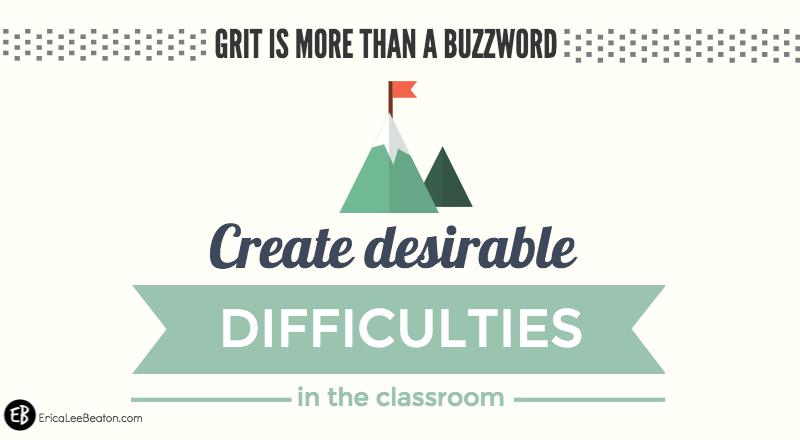
How to Practice This in Your Classroom:
• Institute frequent quizzing.
No, this doesn't mean you should drop a huge pop quiz on your students every day. Instead, create a Kahoot to blend in simple quizzes after reading or lecture, or use entry/exit slips to assess their knowledge from the day before.
I use cumulative quizzes with our study of vocabulary and literacy devices in English. In US History, I'm more purposeful about designing quizzes that reach back to concepts covered in earlier units to recirculate our learning. I also give a lot of practice quizzes where “the points don't matter.”
So, How Are We Supposed to Study?
The most productive learning comes from “self-testing, introducing certain difficulties in practice, waiting to re-study new material until a little forgetting has set in, and interleaving the practice of one skill or topic with another.”
Student Tip #1: Form a Habit of Self-Quizzing
One of the most effective strategies the authors discuss is for learners to “practice retrieving new learning from memory” or quizzing oneself:
“When you read a text or study lecture notes, pause periodically to ask yourself questions like these, without looking in the text:
What are the key ideas?
What terms or ideas are new to me?
How would I define them?
How do the ideas relate to what I already know?…
Generating questions for yourself and writing down the answers is also a good way to study…When you quiz yourself, check your answers to make sure that your judgements of what you know and don't know are accurate” (202).
Most of the teachers I consult share my love of literacy. We know how powerful metacognition is during reading. When students “carry questions with them” as they read, they have greater comprehension.
Yet, practicing initial reading comprehension strategies is not enough for long-term retention.
When I ask my classes how they studied for our last test, overwhelmingly they'll tell me that they reread their notes.
That's it.
Looking at words on a page—that they've already seen before—is their idea of studying.
Far too many students think that simply reading is studying.
The authors explain:
“Rereading has three strikes against it. It is time consuming. It doesn't result in durable memory. And it often involves a kind of unwitting, self-deception, as growing familiarity with the text comes to feel like mastery of the content” (p. 10).
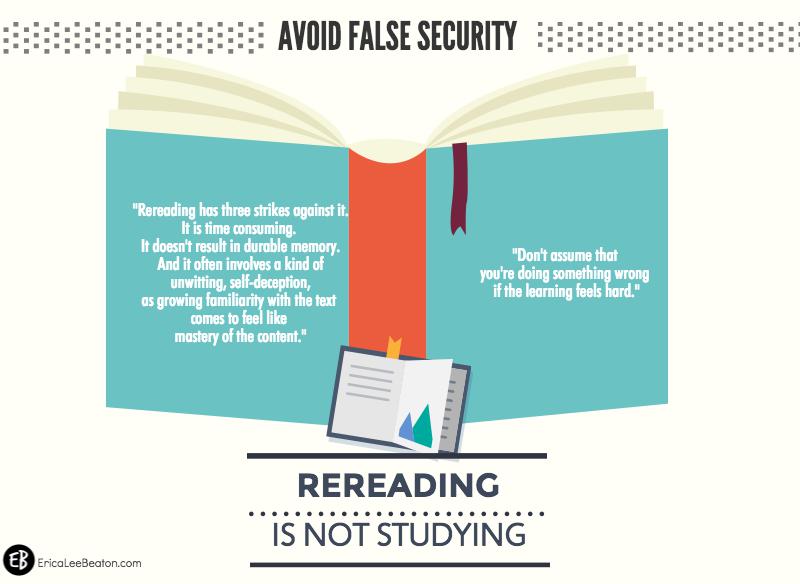
How to Practice This in Your Classroom:
• Teach them how to self-quiz.
Help students learn to ask questions about underlying patterns or how to apply ideas in different contexts.
• Squash rereading as a study technique.
Students feel at ease navigating back through their own notes, but when put to the test there is no transferability of learning. Help them see how rereading makes them think they know more than they do.
Student Tip #2: Space Out Your Retrieval Practice
As students form the habit of self-quizzing, it's essential for them to space out the practice to allow time for forgetting to set in.
Wait. We want them to forget what they've learned?
Yes! When retrieval is difficult, it reinforces the work, shifting it from short-term recall to long-term learning. The researchers use this knowledge to show how ineffective it is to cram the night before a Final Exam.
One of the simple strategies they offer to practice spaced retrieval is the use of flashcards.
Many of us have used flashcards in the past with success. The researchers emphasize how important it is that learners
1) continue shuffling the deck even as they grow confident in their skills and
2) space out their study over time, even building some “sleeps” into the study plan.
“Don't assume that you're doing something wrong if the learning feels hard.”
Eek! The recovering perfectionist in me would've had a hard time hearing that a few years ago.
As a learner—and as a teacher, wife, writer, etc.—I counted on everything to come easy to me and turn out perfectly. If it didn't or I thought it might not, I practiced self-sabotage. I avoided difficult work and procrastinated. I grew up (in both life and my career) being praised for my creativity and intelligence, so when things faced greater challenges I didn't know how to cope.
Sound like any students you know? Maybe, sound like yourself?
Well, give yourself some grace, and don't you go burning out. The good news is that “effortful learning changes the brain” (199).
How to Practice This in Your Classroom:
• Provide simple flashcards.
This year, I printed up one-sided flashcards for my students to complete. I distributed flashcards for Latin Word Chunks, Poetic + Literary Devices, and US Presidents. In the past, I've always suggested kids make them, but only a handful actually did.
Now that I'm providing flashcards, I'll be able to incorporate retrieval practice into my lesson plan. We steal a few minutes between activities to play Memory or Catch Phrase with the terms.
• Discuss the importance of sleep with your students.
I am a happy, deep sleeper, so I was giddy reading about all the benefits of nighttime slumber. {Check out Dave's great article about sleep.} Sleep rebuilds our brain and strengthens our learning, so snoozing is just another reason why spacing out retrieval practice is so awesome.
When learners return to the content to study it again, forgetting will set in. Remember this is good. If we keep going over the same content, it will feel like we've learned the content, but really this immediate recollection creates a false security of knowing. We need to embrace the difficulty of spaced retrieval.
• Help students embrace the struggle of learning.
I want to be transparent about the frustrations and difficulties of learning—not just sympathizing with their trials but continuing to practice vulnerability with them. In the last two years, I've shared with my students a little about how my perfectionism gets in the way of the things I want to do and the stress this causes because recognizing where we have learning gaps is half the battle.
Student Tip #3: Mix Together the Different Types of Problems
Next to self-quizzing and spacing out one's study, students should also make effort to interleave the study of two or more topics, alternating between them.
This piece of research is most clearly communicated in the authors' critique of traditional math textbooks.
In the “real world,” will engineers face A) 20 kinds of one problem, 20 kinds of another, and so on, or will they B) face problems that weave together the work of many different problem types? I know this never-know-what-you're-going-to-get-type of problem-solving is my husband's favorite part of his engineering job.
How to Practice This in Your Classroom:
• Teach them to blend together their various topics of study.
In my US history class, for example, I want students to know more than dates and names. I want them to recognize themes, determine trends, and contextualize events/people by seeing how the dates and names fit into the larger story of our country.
I suggest that they start by working their Literary Devices flashcards for ten minutes and then reflecting on their History reading for another ten minutes before switching back—they are forced to distill the underlying principles and patterns of the content. They have to build the structure of their learning, so it's more than just isolated facts floating around in their notebook.
When students purposefully rotate their study between English and History, they'll have the greatest success if they unearth those structures and principles that connect the facts into larger concepts.
Student Tip #4: Reinforce with Other Research-Based Strategies
Some of the other techniques the researchers discuss are briefly as follows:
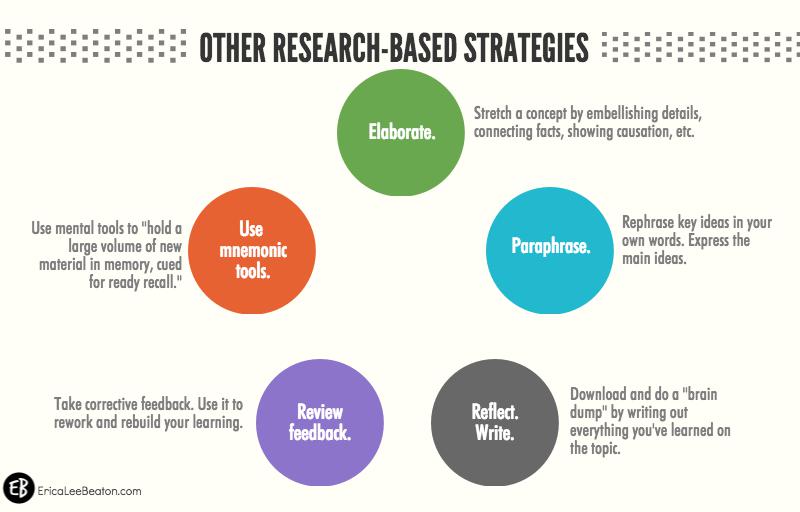
When students join me during my office hours for tutoring, I'm also going to be sure that we space, interleave, and vary our topics of study. On top of that, I want to use the other research tools to deepen their learning.
How to Practice This in Your Classroom:
• Have students close read their notes or classroom anchor charts.
• Regularly practice Think-Pair-Shares where students must paraphrase the teacher or their classmates.
• Before tests/quizzes, have the students download and do a “brain dump.”
• Give appropriate feedback. Have them adjust their learning gaps.
• Share analogies, draw visuals, or create mnemonic devices as mental “cheat sheets.”
Your Turn . . .
As I talk with my students and work with other educators, my hope is that these conversations—about study habits, neuroplasticity, and the downfalls of perfectionism—can continue to bring positive change in our classroom communities.
What strategies have you tried in your classroom that fit with the Make It Stick research?
What hiccups do you see in implementing this research into your room with your students?[hr]
Erica Lee Beaton is a high school English, history, and humanities teacher. She is also a consultant and a writer; you can read much more of her work at her blog, EricaLeeBeaton.com.
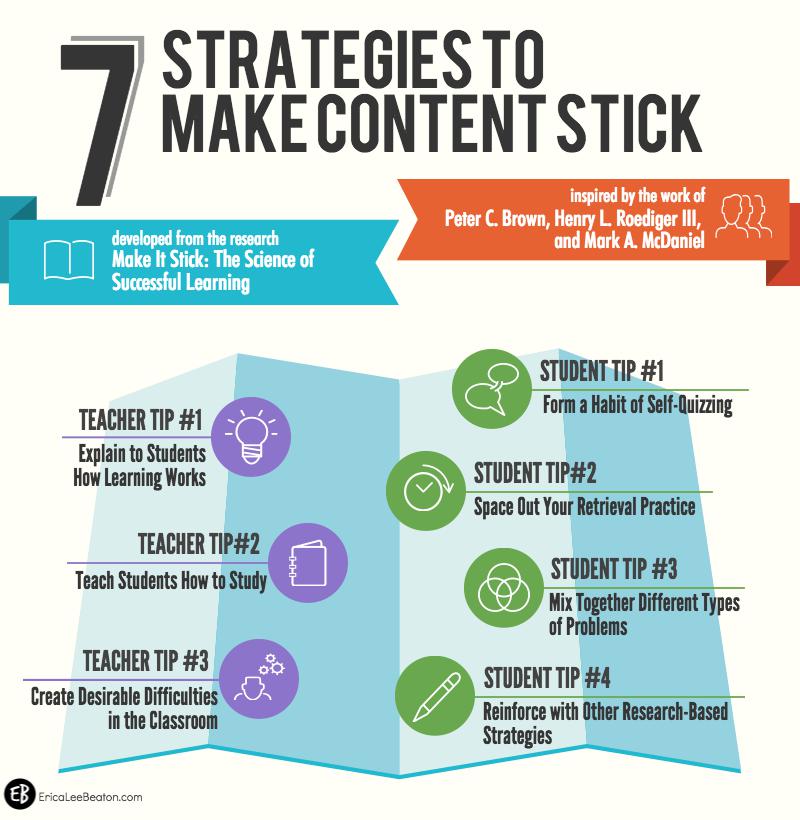

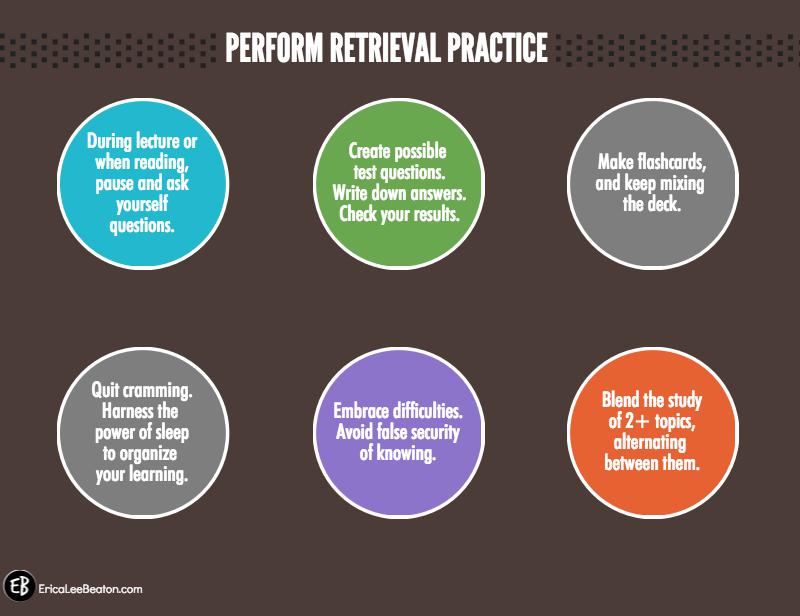
Michael Schulte says
Erica, I really love your idea of incorporating brain research into the article of the week framework. Do you have any suggestions for articles or websites that discuss these topics? I am going to have to add the learning that sticks book to my summer reading list. Thanks!
Erica Beaton says
Thanks for the kind words, Michael. And, yes! You should add this to your to-read list. It’s got more wisdom than one beefy article. 🙂 To answer your question, my students have read excerpts from the Make It Stick book, watched videos from CharacterLab.org, and read lots of Articles of the Week on these concepts. Many of them can be found on my resources page (www.ericaleebeaton.com/resources/) or among Dave’s AoWs (www.davestuartjr.com/resources/article-of-the-week-aow/). Thanks again for the great question.
Lauren O. says
Hi Erica, I loved your article! Do you teach the same students in English and US History? Thank you!
Erica Lee Beaton says
Hi Lauren, thanks for the kind words! I am fortunate to teach a two-hour block of Humanities, where I blend English 10 with US History; however, I also have sections of just history and English.
Dara says
Hi, I am a 10th and 12th grade English teacher. Your article has already inspired me to change some things in my classes, particularly vocabulary study with my sophomores. Like many teachers, I am puzzled and frustrated by the forgetfulness and lack of my students, particularly when I know I spent so much time on a particular skill or concept. While I can immediately think of how many of the tips and strategies apply to disciplines such as history, math and science, I’m curious to how you use them in a typical English classroom. More specifically, what do you do during a novel study to help with comprehension and retention of facts? Or even during writing lessons? I find that when teaching writing, I repeat myself over and over and they forget basic structural lessons. Do you mostly use the tips mentioned in your English class when teaching terms and vocabulary?